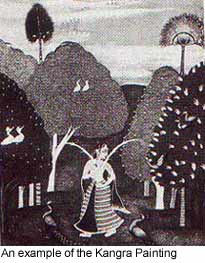

 |  |
|
|
|
Rajput painting has its own peculiar style. The term 'Rajput painting' is applicable to the work of the artists attached to the princely courts of Rajasthan, Central India and the Himalayan foothills of Punjab, from 16th to 19th centuries. The Rajput painting was traditional in its approach and dealt with themes from Indian epics, romantic Vaishnava literature and musical codes from Ragas and Raginis. Sometimes, under the influence of the Mughal tradition, artists also drew scenes from courtly life and the portrait of contemporary personages. It is said that the Rajput painting is sensitive, reticent and tender. It reflects the self-control and serenity of Indian life. It shows close association of art with religion. 
The Rajput painting was done on paper. The artists used techniques similar to those used in the Ajanta frescos. First of all, a pencil outline of the composition was drawn and the main outlines with brush in light red colour. Then the surface was covered with priming of starch paste. Over which the main lines were redrawn in black. After this, the background and the figures were covered with appropriate colours. The Rajput painting can be attributed mainly to two schools of art- the Rajasthani school and the Pahari school. The Rajasthani School The Rajasthani school of art flourished in Mewar, Bundi, Bikaner, Jodhpur, Jaisalmer and Jaipur. Most themes of this school were selected from selected stories e.g. Ram-Lila, Krishna-Lila and Nayika-bheda (that is showing the beloved the various moods). Ritu Charita is also famous and depicts portrait and scenes from seasons, processions, hunting and other royal pursuits. The themes are repetitive but the paintings have their own freshness of life. The Rajasthani style of painting reflects the primitive folk character. The Pahari school It is also called the Kangra school of Painting and has been divided into minor schools like the Kangra, the Guler, the Chamba, and the Garhwal. The painters of this school were greatly influenced by the Bhakti cult and one can see the influence of Kabir and Tulsidas in their work. Devotional love of Krishna and Radha and scenes from the Ramayana and the Mahabharata formed the themes of painting of this school. In this paintings Gods are clad and conceived in human aspect of companionship. The paintings of this school are characterised by elegance and delicacy and an environment of romance in the surroundings of natural beauty. Some of the important paintings are Nal-Damyanti, Krishna and Radha in the rains, Go-Charan (Lord Krishna as the cowherd) and the Govardhan Dharan (Krishna supporting the mount with his finger). |
Copyright ©2000 indiansaga.info. All rights reserved.
By using this service, you accept that you won't copy or use the data given in this website for any commercial purpose.
The material on indiansaga.info is for informational & educational purpose only.
This site is best viewed at 800 X 600 picture resolution.